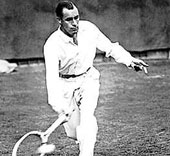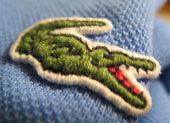
traditional long sleeve woven shirt.
Why are polo shirts called polo shirts? A brief history of the polo shirt.
A polo shirt, simply described, is a T-shaped garment with a knitted collar, short sleeves, a two or three button placket (the neck opening) and is made from a knitted fabric.
But what are the origins of this knitted shirt and why is it called a “polo shirt”?
You may have seen archival footage from the early twentieth century of tennis players running around the court wearing long white flannel trousers and white button-up long sleeved woven shirts complete with neck ties. All very formal but I imagine not very comfortable and practical for such a physical sport.
In the 1920’s a Frenchman named Rene Lacoste was one of the dominant players of the time. He won seven tennis majors or Grand Slam tournaments during his playing career.
Lacoste didn’t like the traditional tennis attire finding it too restrictive and uncomfortable and set about designing something better. The garment he came up with was a white, short sleeved, loosely knitted pique cotton shirt with an unstarched, flat collar, a buttoned placket and a slightly longer tail. He first wore his newly designed shirt at the 1926 US Open. The year after he added a small crocodile emblem to the left breast of his shirts to reflect the “crocodile” nickname he’d been given by tennis fans and the sporting press.

Lacoste’s tennis shirt design overcame lots of the problems associated with traditional tennis shirts. The short cuffed sleeves solved the problem of the rolled long sleeves unrolling and flapping around. The neck opening could be easily loosened by unbuttoning the placket. The knitted collar could be worn upturned to protect the neck from sun burn. The open pique knit fabric breathed. The longer tail helped to prevent the shirt from becoming untucked.
In 1933, after retiring from professional tennis, Lacoste teamed up with a friend in the clothing industry to form a company they named Chemise Lacoste to manufacture and sell his tennis shirts branded with a small crocodile logo.
Around the same time all this was taking place, the sport of polo must have had a much higher profile than it does now. Sometimes called “the sport of kings”, polo was an Olympic sport during the years 1900 to 1939.

Prior to Lacoste’s innovation, polo players were also wearing thick, uncomfortable shirts made from woven cotton. When polo players became aware of Lacoste’s shirt design they readily adopted it for use in their sport. In fact, Lacoste’s design was so dominant in the sport of polo that the term “polo shirt” became the universal name for his shirt. Indeed, tennis players would even refer to their shirt as a “polo shirt” even though their sport had used it earlier than polo players had.
In 1972, Ralph Lauren included his “polo shirt” as a foundation part of his original fashion line called “Polo”. This line, featuring an embroidered emblem depicting a polo player and pony, has no doubt helped to cement the name “polo shirt” to describe the knitted shirt originally designed by Rene Lacoste.
Polo shirts are now widely used in other sports such as golf but have also become a staple garment in the non-sporting world commonly chosen for school uniforms, retail uniforms, hospitality uniforms and tradesmen’s uniforms. Rene Lacoste’s original objective to design a comfortable and practical shirt for tennis has proved to have far reaching and long lasting impact on our fashion and apparel industries.

View our latest range of polo shirts.
(written by Andrew Robinson)
